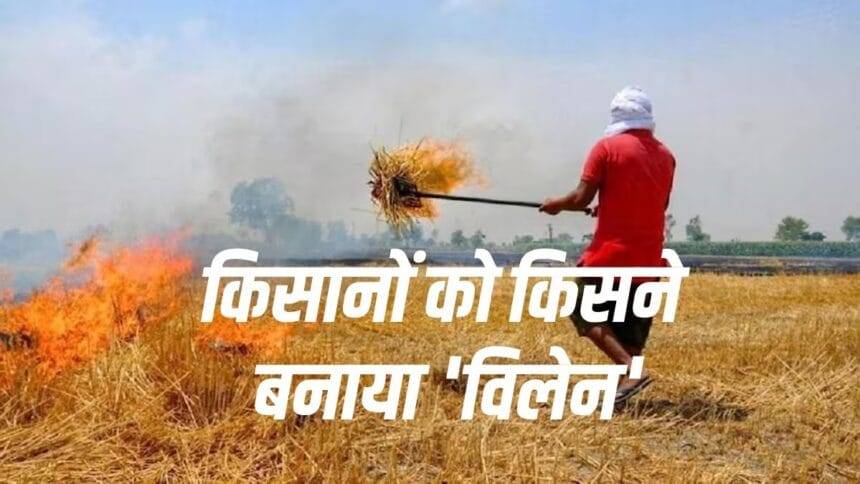Main Points In Hindi (मुख्य बातें – हिंदी में)
यहां दिल्ली-एनसीआर में वायु, जल और ध्वनि प्रदूषण के लिए जिम्मेदार वर्तमान खलनायक के बारे में कुछ मुख्य बिंदु दिए गए हैं:
-
किसानों पर आरोप का सवाल: सरकारों और लोगों ने किसानों के खिलाफ FIR दर्ज कराई हैं, जबकि उन्होंने उन असली प्रदूषकों के खिलाफ कोई मामला दर्ज नहीं किया है जिनका दिल्ली के प्रदूषण में अधिक योगदान है।
-
पराली जलाने की घटनाओं में कमी: हाल के वर्षों में पराली जलाने की घटनाओं में भारी कमी आई है। 2024 में, केवल 7,532 स्थानों पर पराली जलाई गई, जबकि 2020 में यह संख्या 34,824 थी। यह दर्शाता है कि किसानों ने अपनी जिम्मेदारी समझी है।
-
अन्य प्रदूषण स्रोतों पर ध्यान नहीं: जबकि पराली जलाने को प्रदूषण का मुख्य कारण बताया जाता है, सरकारी निर्माण, सड़क किनारे की धूल, और वाणिज्यिक वाहनों जैसे अन्य कारणों को नजरअंदाज किया गया है, जो वायु गुणवत्ता को प्रभावित कर रहे हैं।
-
परिवहन का योगदान: सेंटर फॉर साइंस एंड एनवायरनमेंट (CSE) के अध्ययन में बताया गया है कि दिल्ली में प्रदूषण का 50 प्रतिशत से अधिक स्रोत परिवहन है, जबकि कृषि पर आग लगाने की घटनाओं का इसके बढ़ने पर कम प्रभाव पड़ा है।
- असली प्रदूषणकर्ता कौन हैं?: दिल्ली-एनसीआर के लोग किसानों को अपराधी ठहराने में अपनी गलतियों और कमियों को छुपा रहे हैं, जबकि प्रदूषण के असली कारणों की पहचान करना आवश्यक है।
Main Points In English(मुख्य बातें – अंग्रेज़ी में)
Here are the main points regarding the current pollution issues in Delhi-NCR and the responsibilities associated with it:


-
Declining Stubble Burning Incidents: There has been a significant reduction (about 78%) in stubble burning incidents in Delhi-NCR between 2020 and 2024, indicating that farmers are less responsible for recent pollution levels.
-
Attribution of Pollution Sources: Despite the reduction in stubble burning, pollution in Delhi-NCR continues to rise. The focus on blaming farmers is questioned, as other major contributors such as roadside dust, construction activities, and vehicular emissions are not being adequately addressed.
-
Urban vs. Agricultural Pollution: The Center for Science and Environment (CSE) argues that local sources of pollution, particularly transport, contribute over 50% to Delhi’s pollution levels, highlighting the city’s own role in air quality degradation rather than attributing it primarily to agricultural practices.
-
Government Accountability: The narrative raises questions about the accountability of authorities who target farmers while ignoring other significant pollution sources, suggesting a need for a more holistic approach to tackle pollution in the region.
- Long-Term Trends: Historical data shows a steady decrease in pollution from stubble burning over the years, indicating that attributing current pollution problems solely to this practice ignores broader environmental and urban management issues.
Complete News In Hindi(पूरी खबर – हिंदी में)
दिल्ली-एनसीआर में बढ़ती वायु, जल और ध्वनि प्रदूषण के लिए असली जिम्मेदार कौन है? क्या सरकारी लोग और वे लोग जिन्होंने किसानों के खिलाफ FIR दर्ज की हैं, उनके पास यह हिम्मत है कि वे वास्तव में दिल्ली के प्रदूषण करने वालों के खिलाफ केस दायर करें? क्या दिल्ली के लोग अपनी गलतियों और कमी को छुपाने के लिए किसानों को अपराधी घोषित कर सकते हैं? आखिर क्यों केवल भूसा जलाने को ही दिल्ली के प्रदूषण का जिम्मेदार ठहराया जा रहा है, जबकि किसानों ने लगभग भूसा जलाना बंद कर दिया है? सरकार सड़क के धूल, बिल्डिंग निर्माण, सरकारी निर्माण, SUVs और वाणिज्यिक वाहनों को प्रदूषण के लिए जिम्मेदार क्यों नहीं ठहराती?
उन लोगों के लिए एक चौंकाने वाला तथ्य सामने आया है जो किसानों को प्रदूषण के लिए दोषी मानते हैं। इस वर्ष, 15 सितंबर से 31 अक्टूबर के बीच, भूसा केवल 7,532 स्थानों पर जलाया गया है, जो कि देश के छह राज्यों – पंजाब, हरियाणा, उत्तर प्रदेश, दिल्ली, राजस्थान और मध्य प्रदेश में है। जबकि 2020 में, केवल तीन राज्यों पंजाब, हरियाणा और उत्तर प्रदेश में भूसा 34,824 स्थानों पर जलाया गया था। इसका मतलब है कि पिछले पांच वर्षों में भूसा जलाने की घटनाओं में लगभग 78 प्रतिशत की कमी आई है। फिर भी, प्रदूषण बढ़ रहा है, इसलिए दिल्ली के लोगों को अपनी कमी की ओर देखना चाहिए।
यह भी पढ़ें: बिचौलियों और चावल मिल मालिकों को क्यों गुस्सा है, जब धान की ‘युद्ध’ खत्म होगी?
किसानों की समझदारी
- भारतीय कृषि अनुसंधान परिषद (ICAR) के एक अध्ययन में कहा गया है कि 1 अक्टूबर से 31 अक्टूबर, 2016 के बीच पंजाब में भूसा जलाने की 42,712 घटनाएं हुई थीं। जबकि इस वर्ष, यानी 2024 में, 15 सितंबर से 31 अक्टूबर के बीच केवल 2,950 मामले दर्ज किए गए हैं।
- हरियाणा में, 1 अक्टूबर से 31 अक्टूबर, 2016 के बीच 7,726 मामलों की रिपोर्ट हुई थी, जबकि 15 सितंबर से 31 अक्टूबर, 2024 के बीच केवल 784 मामले सामने आए। किसान अपनी जिम्मेदारियों को समझ रहे हैं, इसलिए अब घटनाएं कम हो गई हैं।
- उत्तर प्रदेश में, 1 अक्टूबर से 31 अक्टूबर, 2016 के बीच 3,904 मामलों की रिपोर्ट हुई थी, जबकि 15 सितंबर से 31 अक्टूबर के दौरान केवल 1,118 मामले दर्ज किए गए। स्पष्ट है कि किसान अब भूसा जलाने से परहेज़ कर रहे हैं।
| वर्ष | मामले |
| 2024 | 7532 |
| 2023 | 13645 |
| 2022 | 19920 |
| 2021 | 18449 |
| 2020 | 34824* |
| #31 अक्टूबर तक | स्रोत: ICAR |
- *2020 से पहले, निगरानी केवल 1 अक्टूबर से की गई थी, और वह भी केवल तीन राज्यों – पंजाब, हरियाणा और उत्तर प्रदेश में।
- 2021 से, भूसा जलाने की घटनाओं की निगरानी 15 सितंबर से शुरू हुई। इसमें छह राज्यों – पंजाब, हरियाणा, उत्तर प्रदेश, दिल्ली, राजस्थान और मध्य प्रदेश को शामिल किया गया।
CSE किसानों के बचाव में
सेंटर फॉर साइंस एंड एनवायरनमेंट (CSE) ने भी किसानों का बचाव किया है और कहा है कि दिल्ली खुद प्रदूषण के लिए जिम्मेदार है। खेतों में भूसा जलाने की घटनाओं में भारी कमी आई है, फिर भी प्रदूषण बढ़ रहा है। स्थानीय स्रोत और विशेषकर परिवहन दिल्ली की खराब हवा में एक बड़ा योगदान देते हैं। CSE के अध्ययन में कहा गया है कि 50 प्रतिशत दैनिक प्रदूषण परिवहन से, 13 प्रतिशत आवासीय स्रोतों से, 11 प्रतिशत उद्योग से और 7 प्रतिशत निर्माण से आता है। इस साल अब तक, खेतों की आग ने दिल्ली की वायु गुणवत्ता पर सबसे कम प्रभाव डाला है।
यह भी पढ़ें: किसानों, उपभोक्ताओं और कपड़ा उद्योग को सभी को कम उपज के कारण चिंता है, कौन जिम्मेदार है?
Complete News In English(पूरी खबर – अंग्रेज़ी में)
Who is the villain currently responsible for increasing air pollution, water pollution and noise pollution in Delhi-NCR? The governments and people who have filed FIRs against farmers for burning stubble, have they ever had the courage to file cases against those who have actually polluted Delhi? Can the people of Delhi-NCR get away with calling farmers criminals to hide their mistakes and shortcomings? Why is it that only stubble is still being held responsible for pollution in Delhi, while farmers have almost stopped burning stubble? After all, why does the government not hold roadside dust, building construction, government construction, SUVs and commercial vehicles responsible for pollution?
An eye-opening figure has come to light for those who blame farmers for pollution. This year, from September 15 to October 31, stubble was burnt at only 7,532 places in six states of the country, Punjab, Haryana, UP, Delhi, Rajasthan and Madhya Pradesh. Whereas in 2020, stubble was burnt at 34,824 places in only three states Punjab, Haryana and UP from October 1 to 31. This means that in five years there has been a reduction of about 78 percent in the incidents of stubble burning. Despite this, pollution is increasing, so the people of Delhi should look towards their shortcomings.
Read this also: Why are the brokers and rice millers angry, when will the paddy ‘war’ be resolved?
Farmers showed wisdom
- A study by the Indian Council of Agricultural Research (ICAR) said that from October 1 to 31, 2016, there were 42,712 incidents of stubble burning in Punjab alone. Whereas, this year i.e. in 2024, only 2,950 cases have been reported between September 15 and October 31.
- There were 7,726 cases of stubble burning in Haryana between October 1 and 31, 2016, whereas only 784 cases were reported between September 15 and October 31, 2024. Farmers are understanding their responsibilities, hence now the incidents have reduced.
- There were 3,904 cases of stubble burning in Uttar Pradesh between October 1 and 31, 2016, whereas only 1,118 cases were reported between September 15 and October 31. It is obvious that farmers are now avoiding the trouble of burning stubble.
| Year | cases |
| 2024 | 7532 |
| 2023 | 13645 |
| 2022 | 19920 |
| 2021 | 18449 |
| 2020 | 34824* |
| #till 31st October | Source: ICAR |
- *Before 2020, monitoring was done from October 1 only, and that too only in three states Punjab, Haryana and UP.
- From 2021 onwards, monitoring of stubble burning incidents started from 15th September. Also six states were included. This includes Punjab, Haryana, UP, Delhi, Rajasthan and Madhya Pradesh.
CSE in defense of farmers
The Center for Science and Environment (CSE) has also defended the farmers and said that Delhi itself is responsible for pollution. There has been a huge reduction in the incidents of stubble burning in the fields, despite the increase in pollution. Local sources and especially transport play a greater role in Delhi’s bad air. The CSE study states that more than 50 percent of the daily pollution comes from transport, 13 percent from residential, 11 percent from industry and 7 percent from construction. So far this year, farm fires have had the least impact on Delhi’s air quality.
Read this also: Farmers, consumers and textile industry are all worried due to low productivity of cotton, who is responsible?






